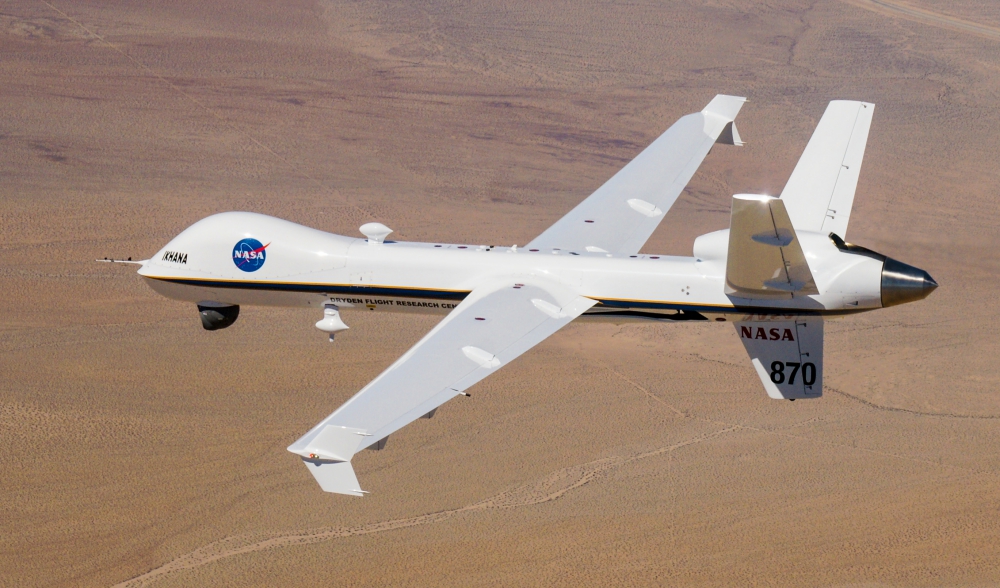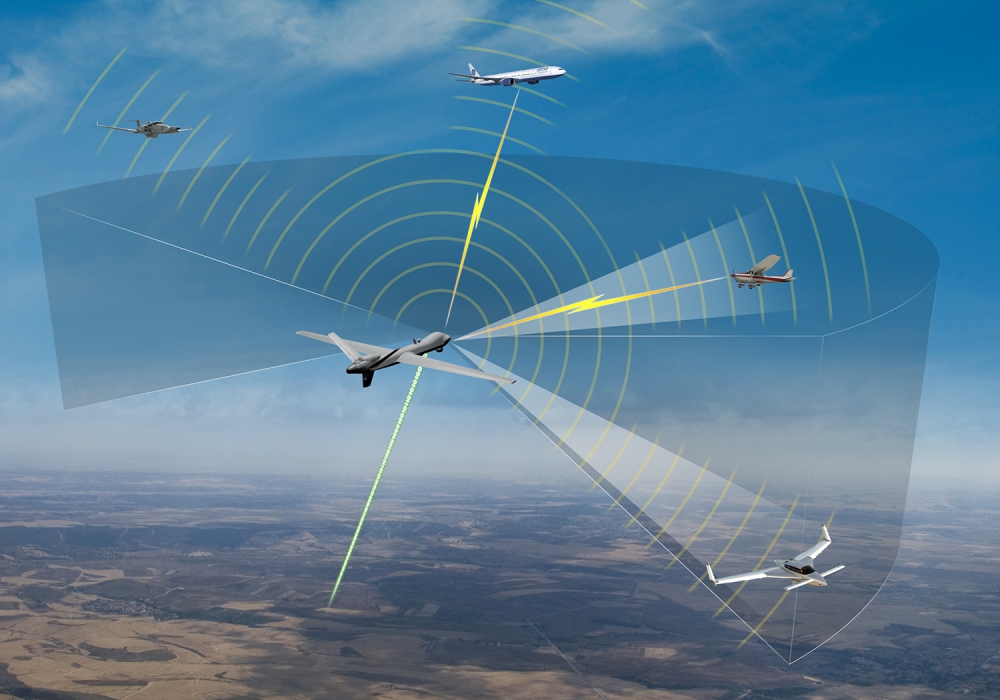First NASA Large UAS Flight in Public Airspace without Chase Plane
A Detect and Avoid (DAA) avionics system developed by General Atomics Aeronautical Systems, Inc. (GA‑ASI) was the key technology that enabled an unmanned aircraft flight through the National Airspace System (NAS) after taking off from southern California on Tuesday.
The DAA system installed on Ikhana, a NASA-owned Predator B/MQ-9 Unmanned Aircraft System (UAS), enabled the UAS to meet the FAA’s 14 CFR 91.113(b) requirement to “see and avoid” other aircraft during today’s flight.
“Our goal of producing UAS that can be certified to fly in non-segregated airspace took a big step forward today,” said Linden Blue, CEO, GA-ASI. “Today’s successful flight is testament to the strong relationship that we have with the FAA, NASA’s Armstrong Flight Research Center and Honeywell to produce the definitive standard for unmanned aircraft operation in congested airspaces.”
The DAA system combines automatic collision avoidance with the ability for the pilot to remain ‘well clear’ of other airspace users. Its subsystems include a GA-ASI-developed airborne radar, a TCAS II and DAA tracking capability from Honeywell, Automatic Dependent Surveillance-Broadcast (ADS-B) IN/OUT, and a Conflict Prediction and Display System.
“Our DAA system is more capable than the collision avoidance systems required on today’s commercial manned aircraft and we believe it far exceeds the average pilot’s ability to ‘see and avoid’,” said David R. Alexander, president, Aircraft Systems, GA-ASI. “The predictive capabilities our system employs create a safe environment for manned and unmanned aircraft to fly together in the NAS.”“This is a huge milestone for our Unmanned Aircraft Systems Integration in the National Airspace System project team,” said Ed Waggoner, NASA’s Integrated Aviation Systems Program director. “We worked closely with our Federal Aviation Administration colleagues for several months to ensure we met all their requirements to make this initial flight happen.”
Flights of large craft like Ikhana, have traditionally required a safety chase aircraft to follow the unmanned aircraft as it travels through the same airspace used by commercial aircraft. The Ikhana flew in accordance with the Federal Aviation Administration’s (FAA) Technical Standard Order 211 — Detect and Avoid Systems — and Technical Standard Order 212 — Air-to-Air Radar for Traffic Surveillance.
The FAA granted NASA special permission to conduct this flight under the authority of a Certificate of Waiver or Authorization on March 30. The certificate permitted Ikhana’s pilot to rely on the latest Detect and Avoid technology, enabling the remote pilot on the ground to see and avoid other aircraft during the flight.
NASA successfully worked with its industry partners to develop a standard for Detect and Avoid technologies, complied with the requirements of the FAA Technical Standard Orders, and garnered flight approval from the FAA.
The Ikhana aircraft was equipped with detect and avoid technologies, including an airborne radar developed by General Atomics Aeronautical Systems, Inc., a Honeywell Traffic Alert and Collision Avoidance System, a Detect and Avoid Fusion Tracker, and an Automatic Dependent Surveillance-Broadcast capability – a surveillance technology where the aircraft determines its position via satellite navigation and periodically broadcasts this information so other aircraft can track it.
The flight took off from Edwards Air Force Base in California and entered controlled air space almost immediately. Ikhana flew into the Class-A airspace, where commercial airliners fly, just west of Edwards at an altitude of about 20,000 feet. The aircraft then turned north toward Fresno, requiring air traffic control to be transferred from the Los Angeles Air Route Traffic Control Center to the Oakland Air Route Traffic Control Center. On the return trip, the pilot headed south toward Victorville, California, requiring communication control to be transferred back to Los Angles.
During the return flight, the pilot began a gentle decent over the city of Tehachapi, California, into Class E airspace — about 10,000 feet — where general aviation pilots fly. The pilot initiated an approach into Victorville airport at 6,000 feet, coordinating in real time with air traffic controllers at the airport. After successfully executing all of these milestones, the aircraft exited the public airspace and returned to its base at Armstrong.
“We are flying with a suite of sophisticated technology that greatly enhances the safety capabilities of pilots flying large unmanned aircraft in the National Airspace System,” said Scott Howe, Armstrong test pilot. “We took the time to mitigate the risks and to ensure that we, as a program, were prepared for this flight.”
Tuesday’s flight was the first remotely-piloted aircraft to use airborne detect and avoid technology to meet the intent of the FAA’s “see and avoid” rules, with all test objectives successfully accomplished.
GA-ASI has been working with the FAA, NASA’s Armstrong Flight Research Center, Honeywell, and other industry partners since 2013 to develop, flight test, and standardize an airborne DAA system. Flight tests on NASA’s Ikhana served as the basis for verification and validation of RTCA DO-365 and DO-366 technical standards for DAA, which were published by RTCA in May 2017. This has put GA-ASI on a path towards leading the industry in operating medium-altitude unmanned aircraft in civilian airspace.
GA-ASI has been developing the DAA system with internal funding for inclusion on all its aircraft. In particular, the new MQ-9B SkyGuardian is provisioned to include the DAA system as a customer option, and the company’s MQ-25 offering also includes the opportunity for the U.S. Navy to incorporate DAA. The DAA system for MQ-9B is designed to comply with the FAA-designated DO-365, “Minimum Operational Performance Standards for Detect and Avoid Systems.”
Source: Press Release





Ingen kommentarer:
Legg inn en kommentar
Merk: Bare medlemmer av denne bloggen kan legge inn en kommentar.